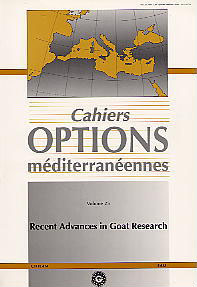| p. 9-16 | Article suivant |
Goat milk production systems: Sub-systems and differentiation factors
The report deals with the goat milk production systems by adapting an intersectorial and interdisciplinary system analysis. In many developing countries, goat milk production is not commercially marketed but produced for subsistence. When the improvement of forage production or the use of concentrates has caused an increase in milk production, there is frequently some difficulty due to the lack of inefficient road systems which prevent such higher production from going towards processing centres or urban markets. Consequently, such a system is practically immobile in progress. In a developed country as USA, 4 million litres goat milk are processed annually as powder and 2.5 million are commercially marketed from individual farms. These data have shown a considerable progress in volume during the last 10 years. In many countries, most of the goat milk produced is either transformed into cheese, directly at the farm, or shipped to a cheese factory where they take care of processing and distribution. At the farm, thanks to moderate investment, the direct milk transformation allows the farmer a value added sales income above the wholesale price to industry. When farms sell milk to dairy factories, the gross margin is highly linked to the milk price which may vary due to the milk quality or to external reasons. For example, goat milk price depends on bacteriological quality, fat and protein percentages. As kidding is seasonal, milk concentration in spring determines an important price decrease.
- [ Afficher ]
- [ Télécharger ]
- [ Exporter la citation ]
Vous pouvez télécharger la citation au format :
- [ Imprimer ]
-
Mots-clés
CAPRIN, FROMAGE DE CHEVRE, PRIX, PRODUCTION LAITIERE, SYSTEME D'EXPLOITATION AGRICOLECiter cet article
Rubino R., Haenlein G.F.W. Goat milk production systems: Sub-systems and differentiation factors. In : Morand-Fehr P. (ed.). Recent advances in goat research. Zaragoza : CIHEAM, 1997. p. 9-16. (Cahiers Options Méditerranéennes; n. 25). 6. International Conference on Goats, 1996/05/06-11, Beijing (China). http://om.ciheam.org/om/pdf/c25/97605950.pdf



